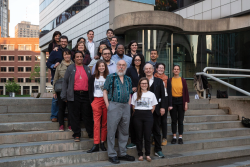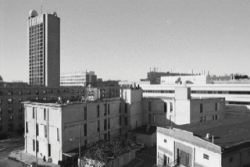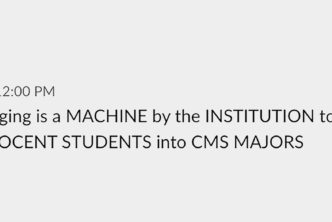This piece originally appeared in In Medias Res 2019.
On the occasion of the Comparative Media Studies program’s first decennial, back in 2009/10, we did a deep dive into its milestones. I have the commemorative publication here on my desk. A timeline runs along the footer of eight pages, marking moments like faculty approvals for our degree programs, awarding of major funding for research projects, and our hosting of big conferences. Important stuff but mostly about nailing down a chronological history that, until then, hadn’t been written out. Likewise, in pieces by Professor William Uricchio and then-Dean Deborah Fitzgerald, we reviewed the rationale for Comparative Media Studies. Let’s describe those pieces’ tone as “intellectual hagiography”: that our bet was right, this place is great, and we knew all along it would be. And our bet was right. And this place is great. But, if we’re honest, to say “we knew it all along” may have been a sleepy-cat-level stretch. It turns out Athena didn’t leap fully armed from Zeus’ head.
The default approach for this year’s account would be to write an updated version of those tenth anniversary pieces, I guess with more humility given the existential challenges we faced that very year and that continued until our successful joining with Writing and Humanistic Studies in 2012/2013. But that would be treading the same ground. Reconsidering that piece today, it turns out the path we didn’t take is perhaps more interesting: people chose to join CMS long before it was a fixed thing, and we never asked why. To get a sense, I spoke with the five people who have been affiliated with CMS for all twenty years. What I found in talking at this personal rather than institutional level was that the draw of CMS was simultaneously more idealistic and pragmatic than we’ve described in the past.

Those five are Professors William Uricchio and Jim Paradis; lecturers Kurt Fendt and Edward Barrett; and alum and current research scientist Philip Tan. Together they give a sense of what it was like to found the academic equivalent of a start-up, with its mix of strategic successes and simple good fortune. I’ll start with Philip. A Singapore native, he came to MIT planning to study computer science. (While no surprise to anyone here, the number is nevertheless striking to many outsiders: more than a quarter of MIT undergrads pursue one of the Electrical Engineering and Computer Sciences majors, slightly more than all other majors in the School of Engineering combined.) If you take 1999 as CMS’s starting point, as we usually do, that’s when Philip was a junior, and he knew by that point that he wanted to major in Comparative Media Studies…except, there wasn’t a major yet. He instead declared what’s called a “major departure”. The School of Humanities, Arts, and Social Science approved his proposal, a major he called “Film & Media Studies and Media Arts & Sciences”. His proposal foreshadowed the official major that was to come. It included Literature subjects like the Film Experience, Introduction to Media Studies, Science Fiction, and Interactive and Non-Linear Narrative. And it effectively set a precedent for the interdisciplinary approach required in today’s major — subjects from the Media Lab; Science, Technology, and Society; Acoustics, an EECS subject; and Foundations in the Visual Arts, an Architecture subject. Edward Barrett served as his advisor.
Philip’s experience was also an example of a recurring theme here, how our lives seem to have intellectual gravity, not necessarily gravity in terms of seriousness but rather how it pulls people’s outside interests in. Or more prosaically, other people need collaborators, and when they hear you share an interest, they jump at the chance to work together. Philip told me, “I’m just this dude hanging around [building] 14” — the campus home of most of MIT’s humanities programs — “and I got roped into a lot of things.” He said that being an undergrad concentrator at the same time the first couple classes of CMS graduate students came through meant there was “a tangle of both undergraduate and grad students who had this kind of peer-to-peer relationship.” To compress the timeline a bit, while in the master’s program Philip was able to work with Professor Thomas DeFrantz on incorporating in his interests in music, dance, and DJ’ing and his work in games. The latter eventually resulted in his 2003 master’s thesis, Tensions in Live- Action Roleplaying Game Design: A Case Study with the MIT Assassins’ Guild, with Barrett again serving as his advisor. That, in turn, led to games research-focused opportunities after the master’s program, including co-directing the Singapore-MIT GAMBIT Game Lab. When the grant for the lab ended in 2012, Philip stayed on to (among other things) co-teach one of our most popular subjects, CMS.608/ CMS.864 Game Design. This, again, from someone who came to MIT expecting to study computer science.
Now to return to Ed Barrett. He’s another one whose outside interests converged within CMS. A poet who joined MIT’s Writing program in a year marked by disasters (Challenger, Chernobyl, Bill Buckner), triumphs (a flyby of Halley’s comet, perestroika, the first unrelated surrogate mother), and disaster-triumphs (the invention of listservs, the “Hand of God” goal, Roy Cohn’s death), Ed saw writing and technology became a focus of his work almost as soon as he got here, when Professor Jim Paradis asked him to join the Athena Writing Project, an early program launched in 1983 for digitally sharing and commenting on text. Many MIT classes took to it, especially within the humanities. Again, though well-known as a poet, Barrett became an authority on hypertext and interactive writing. With Philip Tan as his T.A., Ed taught the first MIT class on the process for creating websites, Communicating in Cyberspace, and he edited or co-edited six volumes for MIT Press under the series title Digital Communication. The publication dates on those books are startling. Text, ConText, and HyperTextWriting with and for the Computer came out in 1988, still a year before the first commercial internet service provider connected users to each other. By 1995 he was already looking at “narrative and other navigational structures in various interactive multimedia systems.” The series culminated in 2001 with The MIT Guide to Teaching Web Site Design. It took just fifteen years to go from no one having any idea whether it’s practical to network computers to edit each other’s stuff, to authoritative essays saying in essence “obviously yes, it’s practical, and beyond that, here’s how you make the final product look good.”
Still, there was enormous uncertainty on the value of something like the Athena Writing Project. The late George Champine wrote a history of Project Athena (as the full distributed computing network was known), in which he mentions that he, Barrett, and Paradis included a “fallback to traditional paper and pencil teaching if the workstation system fails.” But like CMS’s attitude toward most projects, the team exuded some justified optimism. “Although the tools developed are presently not widely available,” Champine wrote, “eventually such tools will be commonplace.”
Paradis was a bigger force behind the success and sustaining of CMS than our prior histories have given him credit for. The strategies he and Professor Kenneth Manning were employing in the 80’s and 90’s to develop a media studies curriculum helped lend substantial institutional support to the creation of the CMS degree programs later on. Crucially, as head of Writing and Humanistic Studies, Jim offered WHS as a co-sponsors of the fledgeling CMS program, along with Literature and Foreign Languages and Literatures. That part I knew, but I wasn’t aware of the key role he played the savvy hires of faculty who served as the bridge between writing and media studies curricula. Together with CMS co-founder Henry Jenkins, Paradis hired computational writing/media scholars Nick Montfort and Fox Harrell and documentary film scholar Vivek Bald. All three were based in WHS but were tied to CMS through various contributions like teaching and advising.
What I also didn’t know until talking with Ed and Jim was how big a factor undergraduate demand played in solidifying internal support for CMS, its degrees, and its model of combining academics with hands-on work. It was simple in fact. Students kept asking for new classes and kept filling them up. There aren’t many concrete measures of a field’s perceived “value” in a university, but enrollment is one of them. It wasn’t long before Comparative Media Studies became the humanities section with the most majors, minors, and concentrators. From just a few subject offerings, it has grown to offer more than seventy. Part of that success was due to partnerships outside MIT. Jenkins and others searched out external funding for projects that provided for undergraduate research opportunities and research assistantships to cover graduate student costs. But they also searched out like-minded faculty. That’s what brought Professor William Uricchio to MIT from Utrecht University. As William wrote to me when I asked him about it:
I was [Utrecht’s] first professor of media studies and designed a program that had a lot of similarities to CMS. We organized subsequent professorships in media history, theory, and technology, cutting across object-specific silos of “film”, “television”, and “new media”. What really worked in the Dutch context was collaborating with partners outside the university, that is, with groups like the Netherlands Film Museum and the Institute for Sound and Vision — both internationally cutting-edge organizations. And we worked with industry players like Endemol; festivals like IDFA; and an array of social movement partners. So the resonance with what would become CMS was clear. Henry Jenkins called, I answered, and I was in place for CMS’s first full year of operations.
William has obviously been here ever since, but he’s been active beyond teaching and personal research. He has served as principal investigator for a number of research groups, with arguably his biggest success being the Open Documentary Lab, launched in 2012.

Lecturer Kurt Fendt, the last of the five lifers I interviewed, had a similar experience. At MIT since 1993, he was teaching German in the Foreign Languages and Literatures section and within a few years running a lab with FLL colleague Ellen Crocker, trying to develop large-scale media projects for different languages and cultures. It was under CMS’s guidance that the lab turned into what became a CMS research group (first named Metamedia, then HyperStudio). But Kurt was also running a forum called the Humanities Technology Think Tank that, in an echo of Ed Barrett’s work, brought faculty together to discuss the potential of digital media technologies for humanities research and education. “It must have been through those conversations and my work in the lab,” Kurt told me, “that Henry invited me to be part of the discussions that conceptualized a graduate program.” He also mentioned something that comes up a lot around here: the satisfaction that comes with working with graduate students. I asked Kurt when CMS first felt “real” to him, and he said it was when the first five graduate students settled into an office next to his in the old building E10, where the newer Media Lab building now stands. There were times he could have left MIT for other opportunities, he said, but working with graduate students and being part of CMS is, well — it’s twenty years later and he’s still here.
Let’s use William’s quote above and Kurt’s experience to step back and appreciate the transformation of the program from a Literature offshoot to the program it is today. William was just the second professor of Comparative Media Studies. There was a joint, untenured appointment between CMS and Writing and Humanistics Studies that existed for a bit, and many faculty from other humanities sections contributed to teaching and advising, but effectively Henry and William were it. That, of course, was unsustainable, and when the program’s future was in doubt after Henry departed for a great opportunity at USC in 2009, Jim Paradis and Dean Deborah Fitzgerald (primarily but with additional credit due others) created this thing now known as Comparative Media Studies/Writing. Since then, under headships by Jim and Edward Schiappa and support from current Dean Melissa Nobles, the number of CMS faculty lines has swelled from two to eleven, with seven of them tenured, and another eleven faculty on the Writing side.
That’s worth highlighting both for the stability it provided but also, to reiterate, how student demand pushed news interests into Comparative Media Studies. Games course enrollment drove us to expand further into gaming culture with the hire of T.L. Taylor. The popularity of cross-listed education classes made it natural to bring both Eric Klopfer and Justin Reich over from the Department of Urban Studies and Planning. And there are similar examples when it came to filling curricular needs in media topics like conservative television, activist media, and Latin America.
Last, I encourage you to go back and read our tenth anniversary magazine, not just to side-eye the “we knew it all along” mode but to read some other essential names and terms. Dean Phil Khoury, Chris Pomiecko and the Media Spectacle, re:constructions, Literature Professor David Thorburn, the Communications Forum…CMS as a program and Comparative Media Studies/Writing as a community wouldn’t be what it is without them.





